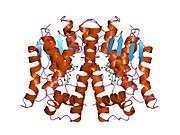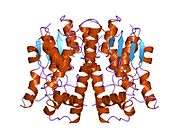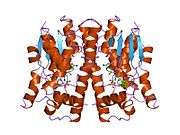Glutathione S-transferase theta-2 is an enzyme that in humans is encoded by the GSTT2 gene.[5][6][7]
Glutathione S-transferase (GSTs) theta 2 (GSTT2) is a member of a superfamily of proteins that catalyze the conjugation of reduced glutathione to a variety of electrophilic and hydrophobic compounds. Human GSTs can be divided into five main classes: Alpha, Mu, Pi, Theta, and Zeta. The theta class members GSTT1 and GSTT2 share 55% amino acid sequence identity and both are thought to have an important role in human carcinogenesis. The theta genes have a similar structure, being composed of five exons with identical exon/intron boundaries.[7]
Further reading
- Hussey AJ, Hayes JD (1992). "Characterization of a human class-Theta glutathione S-transferase with activity towards 1-menaphthyl sulphate". Biochem. J. 286 (3): 929–35. PMC 1132992. PMID 1417752.
- Whittington AT, Webb GC, Baker RT, Board PG (1996). "Characterization of a cDNA and gene encoding the mouse theta class glutathione transferase mGSTT2 and its localization to chromosome 10B5-C1". Genomics. 33 (1): 105–11. doi:10.1006/geno.1996.0165. PMID 8617493.
- Webb G, Vaska V, Coggan M, Board P (1996). "Chromosomal localization of the gene for the human theta class glutathione transferase (GSTT1)". Genomics. 33 (1): 121–3. doi:10.1006/geno.1996.0167. PMID 8617495.
- Mainwaring GW, Williams SM, Foster JR, et al. (1996). "The distribution of theta-class glutathione S-transferases in the liver and lung of mouse, rat and human". Biochem. J. 318 (1): 297–303. PMC 1217621. PMID 8761485.
- Bonaldo MF, Lennon G, Soares MB (1997). "Normalization and subtraction: two approaches to facilitate gene discovery". Genome Res. 6 (9): 791–806. doi:10.1101/gr.6.9.791. PMID 8889548.
- Chelvanayagam G, Wilce MC, Parker MW, et al. (1997). "Homology model for the human GSTT2 Theta class glutathione transferase". Proteins. 27 (1): 118–30. doi:10.1002/(SICI)1097-0134(199701)27:1<118::AID-PROT12>3.0.CO;2-Q. PMID 9037717.
- Rossjohn J, McKinstry WJ, Oakley AJ, et al. (1998). "Human theta class glutathione transferase: the crystal structure reveals a sulfate-binding pocket within a buried active site". Structure. 6 (3): 309–22. doi:10.1016/S0969-2126(98)00034-3. PMID 9551553.
- de Bruin WC, Wagenmans MJ, Board PG, Peters WH (1999). "Expression of glutathione S-transferase theta class isoenzymes in human colorectal and gastric cancers". Carcinogenesis. 20 (8): 1453–7. doi:10.1093/carcin/20.8.1453. PMID 10426791.
- Dunham I, Shimizu N, Roe BA, et al. (1999). "The DNA sequence of human chromosome 22". Nature. 402 (6761): 489–95. doi:10.1038/990031. PMID 10591208.
- de Bruin WC, Wagenmans MJ, Peters WH (2000). "Expression of glutathione S-transferase alpha, P1-1 and T1-1 in the human gastrointestinal tract". Jpn. J. Cancer Res. 91 (3): 310–6. doi:10.1111/j.1349-7006.2000.tb00946.x. PMID 10760690.
- Sprenger R, Schlagenhaufer R, Kerb R, et al. (2001). "Characterization of the glutathione S-transferase GSTT1 deletion: discrimination of all genotypes by polymerase chain reaction indicates a trimodular genotype-phenotype correlation". Pharmacogenetics. 10 (6): 557–65. doi:10.1097/00008571-200008000-00009. PMID 10975610.
- Venter JC, Adams MD, Myers EW, et al. (2001). "The sequence of the human genome". Science. 291 (5507): 1304–51. doi:10.1126/science.1058040. PMID 11181995.
- Strausberg RL, Feingold EA, Grouse LH, et al. (2003). "Generation and initial analysis of more than 15,000 full-length human and mouse cDNA sequences". Proc. Natl. Acad. Sci. U.S.A. 99 (26): 16899–903. doi:10.1073/pnas.242603899. PMC 139241. PMID 12477932.
- De Maria F, Pedersen JZ, Caccuri AM, et al. (2004). "The specific interaction of dinitrosyl-diglutathionyl-iron complex, a natural NO carrier, with the glutathione transferase superfamily: suggestion for an evolutionary pressure in the direction of the storage of nitric oxide". J. Biol. Chem. 278 (43): 42283–93. doi:10.1074/jbc.M305568200. PMID 12871945.
- Collins JE, Wright CL, Edwards CA, et al. (2005). "A genome annotation-driven approach to cloning the human ORFeome". Genome Biol. 5 (10): R84. doi:10.1186/gb-2004-5-10-r84. PMC 545604. PMID 15461802.
- Gerhard DS, Wagner L, Feingold EA, et al. (2004). "The status, quality, and expansion of the NIH full-length cDNA project: the Mammalian Gene Collection (MGC)". Genome Res. 14 (10B): 2121–7. doi:10.1101/gr.2596504. PMC 528928. PMID 15489334.
- Jang SG, Kim IJ, Kang HC, et al. (2007). "GSTT2 promoter polymorphisms and colorectal cancer risk". BMC Cancer. 7: 16. doi:10.1186/1471-2407-7-16. PMC 1793996. PMID 17250773.
PDB gallery |
|---|
1ljr: GLUTATHIONE TRANSFERASE (HGST T2-2) FROM HUMAN 2ljr: GLUTATHIONE TRANSFERASE APO-FORM FROM HUMAN 3ljr: GLUTATHIONE TRANSFERASE (THETA CLASS) FROM HUMAN IN COMPLEX WITH THE GLUTATHIONE CONJUGATE OF 1-MENAPHTHYL SULFATE |







